Story that lower Mms woofers have more open sound is yesterdays news. <snip>
Absolutely right! I made same experiences. That's why i always uses 15" with small voice coils and low Mms as mentioned here in #2511:
https://www.diyaudio.com/forums/mul...m-spl-low-distortion-2-a-252.html#post5902536
Another light cone, which actually shows the steep impedance peak in real life (that Tony Gee referred to):
Attachments
-
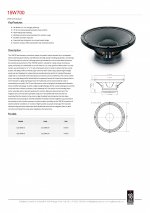 eighteen_sound_15w700_spec_Pagina_1.jpg421.8 KB · Views: 210
eighteen_sound_15w700_spec_Pagina_1.jpg421.8 KB · Views: 210 -
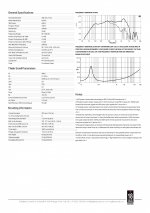 eighteen_sound_15w700_spec_Pagina_2.jpg478.6 KB · Views: 202
eighteen_sound_15w700_spec_Pagina_2.jpg478.6 KB · Views: 202 -
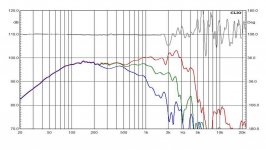 eighteen_sound_15w700_risp.jpg91.5 KB · Views: 176
eighteen_sound_15w700_risp.jpg91.5 KB · Views: 176 -
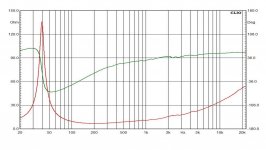 eighteen_sound_15w700_imp.jpg81.3 KB · Views: 162
eighteen_sound_15w700_imp.jpg81.3 KB · Views: 162 -
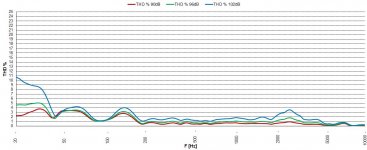 eighteen_sound_15w700_thd.jpg136.9 KB · Views: 144
eighteen_sound_15w700_thd.jpg136.9 KB · Views: 144 -
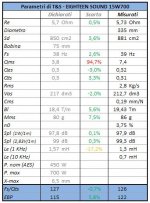 eighteen_sound_15w700_par.jpg51.2 KB · Views: 100
eighteen_sound_15w700_par.jpg51.2 KB · Views: 100
Last edited:
Yeah, actually I see quite a lot of babbling in that... Or maybe i'm just babbling. It's up to you to decide.
You won't be able to breath life into either the TBX100, NBX100, or BG100 with a low power SET or solid state Class A amplifier.
I don't see any reason that this would be the case and honestly I don't believe it. The higher efficiency is an advantage to low power amps.
Gedlee -
Turns out that the "subtractive eq is best" is a myth that I've held on to...it is based in truth from once upon a time but still, I suggest that no eq is better than having to eq. Unless using linear equalization, eq does cause phase shift, and if you are using room correction, wouldn't a scenario where the left channel needed significantly different boost/attention than the right channel, cause phase complications that would make for a higher variance of result as opposed to listening position
I was exaggerating about "no room" maybe I should of said less room? A reflection is a distortion....if its not identical to the source signal in spl or timing.....essentially it is a distortion to the gravest sense of the definition of the word even if a certain level of distortion is perceived as natural.
Distortion - : falsified reproduction of an audio or video signal (see SIGNAL entry 1 sense 4b) caused by change in the wave form of the original signal
"Rooms affect sound quality but entirely in the frequency domain" Constant Directivity horns affect sound quality....in the frequency domain, not in a good way.
Thanks for the correcting information. Correct away
To me "distortion" is only nonlinear, not linear which is simply a frequency response issue. So we need to be clear on what type of distortion we are talking about. Linear distortion is perfectly correctable, nonlinear not so much.
As to EQ and phase changes, this is a complex subject for which one cannot say much without specifics. But to say that "no EQ" is prefered is simply old school as "perfect" EQ is possible and doable so why would one not use this tool?
Your example does not fit with me since I don;t do in-room EQ at all. The speakers should never be modified to adapt to the room except at LFs. They should be anechoic as good as possible and then left alone.
This is simply false. What you hear is nonlinear in level, but it is not the speaker doing this, it is your hearing. It is a psychoacoustical effect much akin to the Fletcher-Munson effects of hearing.Story that lower Mms woofers have more open sound is yesterdays news.
In my experience story about high and low Mms woofers is confusing because of many factors. Main one being room/distance from where it is listened. High Mms woofers do not act linear in regard to how much power they receive.
While i play it in my room (and i have designed few 2 way waveguide loaded loudspeakers) there is a threshold for high Mms woofers when it begins to sound alive. That difference depends not only on Mms but on Cms to. So when you put the room in to equation, you see where all of the confusion origins. If i try (as i have) to listen two way loudspeaker using Beyma SM115K and 18" oswg with B&C DE250-8 and with crossover frequency at 900Hz in my room of 17sqm, it sounds muddy at normal listening levels. As i begin to turn it up more and more, when i get to about 5W it starts to come alive. When i bring the speakers to my friend that doesn't live in a flat but in a house with 50sqm living room, it sounds very much alive when we get to normal listening level. If we would be listening those loudspeakers in our rooms not knowing about each other, we would write diametrically different impressions of sound on forum.
In conclusion, of course that new age woofers sound better with more juice in them and in larger venues - they are built for that as their primary purpose. Or maybe i'm just babbling. It's up to you to decide.
I have decided, and I simply disagree with you completely. You are equating all kinds of room and design issues into them being driver issues. Poorly designed two ways, especially with horns can sound god awful. Done well they excel beyond anything else that I have heard. The drivers are a commodity, the system design is all-important.
An awful lot of Audio Dogma happening in this thread. Much of it simply not correct. Don't hold on to your unverified/obsolete beliefs too long or you will never get to what you are looking for.
Yeah, actually I see quite a lot of babbling in thatSorry guys, but it doesn't make any sense to me. I don't know what to "sound muddy" means, never have experienced that (maybe I just do things differently), but what has Cms to do with midrange performace of the driver where the excursion is almost none? Of course mass means inertia but then there is the force factor (Bl) - higher mass means just nothing if you move it with a stronger force. I just cant't see the solid physical rationale behind all these claims. If your loudspeaker doesn't sound right at lower volumes, just add more bass, i.e. EQ it better...
I agree.
PS. Been to Prague several times. It's one of my favorite cities anywhere.
What about Eighteen Sound - Professional loudspeakers ?)))
But high Qes.
But high Qes.
Low Cms and large Mms inevitably lead to some inertia
I would avoid the bass section with this kind of design.
The latter is true, except for the fact that it doesn't apply to the η₀ of the woofers in the NS-15 and Summa:I don't see any reason that this would be the case and honestly I don't believe it. The higher efficiency is an advantage to low power amps.
- 15NBX100: 1.829%
Reference power calculated at ± 30% for an Xmax of ± 10.00 mm = 1610 Watts. (1127 to 2301 Watts)
- 15TBX100: 1.570%
Reference power calculated at ± 30% for an Xmax of ± 9.00 mm = 1406 Watts. (984 to 2008 Watts)
For comparison:
- Altec 416-8B: 3.492%
Reference power calculated at ± 30% for an Xmax of ± 3.81 mm = 22 Watts. (16 to 32 Watts).
Last edited:
Gedlee you make good points. There is a place where linear eq isn't acceptable, as that is what I think you are referring to as "perfect"....basically any place where low latency is desirable. Minimum phase might be the perfect eq, either way, point made. I also am aware of the best practice of, Not, correcting above ~200hz, so to that, we are on accord.
I am not sure where in-between "An anechoic room sounds terrible" and " They should be anechoic as good as possible and then left alone." I should aim for. I believe this is related to a goal for RT60? Actually I'd really like to hear how you approach room treatment. My goal is one that you are familiar with, I am sure. I need to be able to make the best eq and level choices possible within mix/mastering. If you could maybe make some bullet points on what a room built for that task would require. I'd appreciate it. Any reading material you can suggest, is welcomed.
"Muddy" in the studio means, an over abundance of midbass

I am not sure where in-between "An anechoic room sounds terrible" and " They should be anechoic as good as possible and then left alone." I should aim for. I believe this is related to a goal for RT60? Actually I'd really like to hear how you approach room treatment. My goal is one that you are familiar with, I am sure. I need to be able to make the best eq and level choices possible within mix/mastering. If you could maybe make some bullet points on what a room built for that task would require. I'd appreciate it. Any reading material you can suggest, is welcomed.
"Muddy" in the studio means, an over abundance of midbass

Last edited:
Here are some (independent) measurements of the FaitalPRO 15PR400.
Response, impedance, THD and interestingly: specified versus measured T&S parameters.
There are cone issues? starting at 300Hz which are not apparent in 15BG100...
So, Fletcher-Munson effect in my room but not at my friends house ? Volume level at listening position measured both times ? Right....This is simply false. What you hear is nonlinear in level, but it is not the speaker doing this, it is your hearing. It is a psychoacoustical effect much akin to the Fletcher-Munson effects of hearing...
Truth doesn't need your agreement. In more than one thread i opened, the way i design my speakers can be seen - poorly or well. Difference between you and me is that i profit nothing out of any stand point so i speak as i gather my experience....This is simply false. What you hear is nonlinear in level, but it is not the speaker doing this, it is your hearing. It is a psychoacoustical effect much akin to the Fletcher-Munson effects of hearing.
I have decided, and I simply disagree with you completely. You are equating all kinds of room and design issues into them being driver issues. Poorly designed two ways, especially with horns can sound god awful. Done well they excel beyond anything else that I have heard. The drivers are a commodity, the system design is all-important.
An awful lot of Audio Dogma happening in this thread. Much of it simply not correct. Don't hold on to your unverified/obsolete beliefs too long or you will never get to what you are looking for.
I have what i was looking for so i don't chase anything. Everything i do now is just because it is interesting and i can.
I'm still in awe about your claims, few years back, that all compression drivers sound the same.
Like i said, it's up to you/everyone to decide if it is babbling or not. If you ever want to test claims about high and low Mms yourself: use DSP, crossover frequency with tweeter around 900Hz, gated response of drivers 0-180 deg in 10deg increments for crossover design and with everything else being the same but woofers. I'll be glad to hear what would be your experience and preference.Yeah, actually I see quite a lot of babbling in thatSorry guys, but it doesn't make any sense to me. I don't know what to "sound muddy" means, never have experienced that (maybe I just do things differently), but what has Cms to do with midrange performace of the driver where the excursion is almost none? Of course mass means inertia but then there is the force factor (Bl) - higher mass means just nothing if you move it with a stronger force. I just cant't see the solid physical rationale behind all these claims. If your loudspeaker doesn't sound right at lower volumes, just add more bass, i.e. EQ it better...
Also, thanks for your software. Didn't get to use it yet but soon
So, Fletcher-Munson effect in my room but not at my friends house ? Volume level at listening position measured both times ? Right.
They are different rooms so the way the design works with the room is different. This is likely the better explanation than "nonlinear woofers".
As far as "truth" goes, truth has to be based on facts (not currently PC of course). Facts are what I have dealt with for more than 50 years so that's the expertise level that your facts need to contend with.
I have not sold anything for more than four years.
You are a genious guy, no doubt about that. You are one of most important figures that moved the controlled directivity story in to mainstream. But you are not the only genius i've had the chance to swap opinions that thought to know everything there is to know about some field. Otherwise we would all be listening your speakers, right ?
Edit: I am genuinely sorry business is slowing down for you. I see lots of poorly designed speakers being sold for much money just because they exibit at some famous show - but in todays world i guess that's necessity.
Edit: I am genuinely sorry business is slowing down for you. I see lots of poorly designed speakers being sold for much money just because they exibit at some famous show - but in todays world i guess that's necessity.
Last edited:
Gedlee you make good points. There is a place where linear eq isn't acceptable, as that is what I think you are referring to as "perfect"....basically any place where low latency is desirable. Minimum phase might be the perfect eq, either way, point made. I also am aware of the best practice of, Not, correcting above ~200hz, so to that, we are on accord.
I am not sure where in-between "An anechoic room sounds terrible" and " They should be anechoic as good as possible and then left alone." I should aim for. I believe this is related to a goal for RT60? Actually I'd really like to hear how you approach room treatment. My goal is one that you are familiar with, I am sure. I need to be able to make the best eq and level choices possible within mix/mastering. If you could maybe make some bullet points on what a room built for that task would require. I'd appreciate it. Any reading material you can suggest, is welcomed.
I meant that the speakers should be developed for the best anechoic response and then not changed once in the room.
Read my books and publications on room acoustics (all available on my web sight as downloads) and look elsewhere at DIY. It's too far off-topic to get into the huge subject of room acoustics. Basically it's all about two areas of interest, both dealt with completely differently. The LFs need a well damped room, several subs and EQ to blend everything together. HFs need a reverberant room and high DI speakers to avoid the early reflections (imaging) but enhance the later ones (spaciousness.)
If I have a minimum phase system, as almost all good systems are, then if I correct the frequency response I am simultaneously correcting the phase. "linear" or non-minimum phase EQ, is almost never required - I don't use any at all and I have a very smooth magnitude and phase system.
Otherwise we would all be listening your speakers, right ?
If performance drove sales, then yes, but that is not how audio works. Audio is about fashion and hype - little else.
You can listen to who you want, but my tendency is always to go to the best experts.
My business is closed because I am retired and I'd rather make glass now than speakers. I'm well set enough to do what I want.
I do get annoyed when people claim my position is based on my wallet. That is offensive and incorrect.
You may be offended but you wouldn't thought so ?
You are an expert, one of the important ones that i read. But none of you that i like to read i consider all-knowing. Like you have your dissagreement about certain points with Floyd Tool although he is no less expert than you. Numerous times you said that stuff Siegfrid Linkwitz did sounded plain wrong (you only liked the bass but it was too low sensitivity for you to use in your system), does your dissagreement makes him less of an expert ?
When i get to 50 years experience in acoustics, i'd really like you to be here so i can tell you - i told you so
It is not about things on which you agree on. I like to look at things that you don't agree about. That is the place for advancement and learning.
You are an expert, one of the important ones that i read. But none of you that i like to read i consider all-knowing. Like you have your dissagreement about certain points with Floyd Tool although he is no less expert than you. Numerous times you said that stuff Siegfrid Linkwitz did sounded plain wrong (you only liked the bass but it was too low sensitivity for you to use in your system), does your dissagreement makes him less of an expert ?
When i get to 50 years experience in acoustics, i'd really like you to be here so i can tell you - i told you so
It is not about things on which you agree on. I like to look at things that you don't agree about. That is the place for advancement and learning.
Last edited:
You may be offended but you wouldn't thought so ?
You are an expert, one of the important ones that i read. But none of you i consider all-knowing. Like you have your dissagreement about certain points with Floyd Tool although he is no less expert than you. When i get to 50 years experience in acoustics, i'd really like you to be here so i can tell you - i told you so
When it comes to the subjects of audio and acoustics, it's an extremely rare event when Earl gets it wrong. WHG
When it comes to the subjects of audio and acoustics, it's an extremely rare event when Earl gets it wrong. WHG
Thanks Bill.
The areas that Floyd and I disagree on are very small and he has even soften his position towards mine. Yes Floyd is a real expert in evaluation. He and Sean have done the world a serious service. But neither of them designs loudspeakers. They can tell you how they perform and how they should perform, but getting there is not their forte. As for Sigfried, he and I disagreed on several things, but he was not really an audio guy by profession. He only did that seriously when he retired from HP. Audio has always been my profession.
- Home
- Loudspeakers
- Multi-Way
- Is it possible to cover the whole spectrum, high SPL, low distortion with a 2-way?